Distinguishing Algal Blooms from Aquatic Vegetation in Chinese Lakes Using Sentinel 2 Image
Abstract
:1. Introduction
2. Materials and Methods
2.1. Study Areas
2.2. Remote Sensing Data
2.3. Methods
2.3.1. Data Preprocessing
2.3.2. Accuracy Assessment
3. Results
3.1. Classification Index, Time Scale and Threshold Selection
3.1.1. Indices and Thresholds for Extracting Algal Blooms and Aquatic Vegetation
3.1.2. Time Range for Calculating VPF
3.2. Results of VPF Differentiation between Algal Blooms and Aquatic Vegetation
3.3. Precision Validation Results
3.3.1. Precision of the Extraction of Algal Blooms and Aquatic Vegetation
3.3.2. Precision in Extracting the Extent of Aquatic Vegetation
3.3.3. Overall Accuracy of Identification
4. Discussion
4.1. The Advantages of Model for Extracting Vegetation Information in Turbid Water
4.2. Validation with the Absence of Actual Measurement Data
4.3. Spatial Transferability of the Model
4.4. Analysis of Advantages and Disadvantages
5. Conclusions
Supplementary Materials
Author Contributions
Funding
Data Availability Statement
Conflicts of Interest
References
- Jeppesen, E.; Sondergaard, M.; Jensen, J.P.; Kanstrup, E.; Petersen, B. Macrophytes and turbidity in brackish lakes with special emphasis on the role of top-down control. In Proceedings of the Workshop on the Structuring Role of Submerged Macrophytes in Lakes, Freshwater Ctr, Silkeborg, Denmark, 16–20 June 1996. [Google Scholar]
- Scheffer, M.; Hosper, S.H.; Meijer, M.L.; Moss, B.; Jeppesen, E. Alternative Equilibria in Shallow Lakes. Trends Ecol. Evol. 1993, 8, 275–279. [Google Scholar] [CrossRef]
- Anderson, D.M.; Glibert, P.M.; Burkholder, J.M. Harmful algal blooms and eutrophication: Nutrient sources, composition, and consequences. Estuaries 2002, 25, 704–726. [Google Scholar] [CrossRef]
- Wells, M.L.; Trainer, V.L.; Smayda, T.J.; Karlson, B.S.O.; Trick, C.G.; Kudela, R.M.; Ishikawa, A.; Bernard, S.; Wulff, A.; Anderson, D.M.; et al. Harmful algal blooms and climate change: Learning from the past and present to forecast the future. Harmful Algae 2015, 49, 68–93. [Google Scholar] [CrossRef] [Green Version]
- Harke, M.J.; Steffen, M.M.; Gobler, C.J.; Otten, T.G.; Wilhelm, S.W.; Wood, S.A.; Paerl, H.W. A review of the global ecology, genomics, and biogeography of the toxic cyanobacterium, Microcystis spp. Harmful Algae 2016, 54, 4–20. [Google Scholar] [CrossRef] [Green Version]
- Ho, J.C.; Michalak, A.M.; Pahlevan, N. Widespread global increase in intense lake phytoplankton blooms since the 1980s. Nature 2019, 574, 667–670. [Google Scholar] [CrossRef]
- Paerl, H.W.; Otten, T.G. Harmful Cyanobacterial Blooms: Causes, Consequences, and Controls. Microb. Ecol. 2013, 65, 995–1010. [Google Scholar] [CrossRef]
- Sellner, K.G.; Doucette, G.J.; Kirkpatrick, G.J. Harmful algal blooms: Causes, impacts and detection. J. Ind. Microbiol. Biotechnol. 2003, 30, 383–406. [Google Scholar] [CrossRef]
- Gorelick, N.; Hancher, M.; Dixon, M.; Ilyushchenko, S.; Thau, D.; Moore, R. Google Earth Engine: Planetary-scale geospatial analysis for everyone. Remote Sens. Environ. 2017, 202, 18–27. [Google Scholar] [CrossRef]
- Wynne, T.T.; Stumpf, R.P.; Tomlinson, M.C.; Dyble, J. Characterizing a cyanobacterial bloom in western Lake Erie using satellite imagery and meteorological data. Limnol. Oceanogr. 2010, 55, 2025–2036. [Google Scholar] [CrossRef] [Green Version]
- Junsheng, L.; Di, W.; Yuanfeng, W.; Haixia, L.; Xi, S.; Hao, Z. Identification of algae-bloom and aquatic macrophytes in Lake Taihu from in-situ measured spectra data. Lake Sci. 2009, 21, 215–222. [Google Scholar] [CrossRef] [Green Version]
- Oyama, Y.; Matsushita, B.; Fukushima, T. Distinguishing surface cyanobacterial blooms and aquatic macrophytes using Landsat/TM and ETM plus shortwave infrared bands. Remote Sens. Environ. 2015, 157, 35–47. [Google Scholar] [CrossRef]
- Liu, X.; Zhang, Y.; Shi, K.; Zhou, Y.; Tang, X.; Zhu, G.; Qin, B. Mapping Aquatic Vegetation in a Large, Shallow Eutrophic Lake: A Frequency-Based Approach Using Multiple Years of MODIS Data. Remote Sens. 2015, 7, 10295–10320. [Google Scholar] [CrossRef] [Green Version]
- Liang, Q.; Zhang, Y.; Ma, R.; Loiselle, S.; Li, J.; Hu, M. A MODIS-Based Novel Method to Distinguish Surface Cyanobacterial Scums and Aquatic Macrophytes in Lake Taihu. Remote Sens. 2017, 9, 133. [Google Scholar] [CrossRef] [Green Version]
- Zhu, Q.; Li, J.; Zhang, F.; Shen, Q. Distinguishing Cyanobacterial Bloom from Floating Leaf Vegetation in Lake Taihu Based on Medium-Resolution Imaging Spectrometer (MERIS) Data. IEEE J. Sel. Top. Appl. Earth Obs. Remote Sens. 2018, 11, 34–44. [Google Scholar] [CrossRef]
- Jiang, H.; Zhao, D.; Cai, Y.; An, S. A Method for Application of Classification Tree Models to Map Aquatic Vegetation Using Remotely Sensed Images from Different Sensors and Dates. Sensors 2012, 12, 12437–12454. [Google Scholar] [CrossRef] [Green Version]
- DomaÇ, A.; Süzen, M.L. Integration of environmental variables with satellite images in regional scale vegetation classification. Int. J. Remote Sens. 2006, 27, 1329–1350. [Google Scholar] [CrossRef]
- Filippi, A.M.; Jensen, J.R. Fuzzy learning vector quantization for hyperspectral coastal vegetation classification. Remote Sens. Environ. 2006, 100, 512–530. [Google Scholar] [CrossRef]
- Dogan, O.K.; Akyurek, Z.; Beklioglu, M. Identification and mapping of submerged plants in a shallow lake using quickbird satellite data. J. Environ. Manag. 2009, 90, 2138–2143. [Google Scholar] [CrossRef]
- Luo, J.; Ma, R.; Duan, H.; Hu, W.; Zhu, J.; Huang, W.; Lin, C. A New Method for Modifying Thresholds in the Classification of Tree Models for Mapping Aquatic Vegetation in Taihu Lake with Satellite Images. Remote Sens. 2014, 6, 7442–7462. [Google Scholar] [CrossRef] [Green Version]
- Ma, R.; Duan, H.; Gu, X.; Zhang, S. Detecting aquatic vegetation changes in Taihu Lake, China using multi-temporal satellite imagery. Sensors 2008, 8, 3988–4005. [Google Scholar] [CrossRef] [Green Version]
- Shi, K.; Zhang, Y.; Zhou, Y.; Liu, X.; Zhu, G.; Qin, B.; Gao, G. Long-term MODIS observations of cyanobacterial dynamics in Lake Taihu: Responses to nutrient enrichment and meteorological factors. Sci. Rep. 2017, 7, 40326. [Google Scholar] [CrossRef] [PubMed] [Green Version]
- Feng, L.; Hou, X.; Liu, J.; Zheng, C. Unrealistic phytoplankton bloom trends in global lakes derived from Landsat measurements. Nature 2020. [Google Scholar] [CrossRef]
- Hu, C.; Lee, Z.; Ma, R.; Yu, K.; Li, D.; Shang, S. Moderate Resolution Imaging Spectroradiometer (MODIS) observations of cyanobacteria blooms in Taihu Lake, China. J. Geophys. Res. Ocean. 2010, 115. [Google Scholar] [CrossRef] [Green Version]
- Hu, C.; Cannizzaro, J.; Carder, K.L.; Muller-Karger, F.E.; Hardy, R. Remote detection of Trichodesmium blooms in optically complex coastal waters: Examples with MODIS full-spectral data. Remote Sens. Environ. 2010, 114, 2048–2058. [Google Scholar] [CrossRef]
- Zhang, C.X.; Pei, H.C.; Jia, Y.F.; Bi, Y.L.; Lei, G.C. Effects of air quality and vegetation on algal bloom early warning systems in large lakes in the middle-lower Yangtze River basin. Environ. Pollut. 2021, 285, 117455. [Google Scholar] [CrossRef]
- Hu, C. A novel ocean color index to detect floating algae in the global oceans. Remote Sens. Environ. 2009, 113, 2118–2129. [Google Scholar] [CrossRef]
- Bloesch, J. Mechanisms, Measurement and Importance of Sediment Resuspension in Lakes. Mar. Freshw. Res. 1995, 46, 295–304. [Google Scholar] [CrossRef]
- Shi, K.; Zhang, Y.; Zhu, G.; Liu, X.; Zhou, Y.; Xu, H.; Qin, B.; Liu, G.; Li, Y. Long-term remote monitoring of total suspended matter concentration in Lake Taihu using 250 m MODIS-Aqua data. Remote Sens. Environ. 2015, 164, 43–56. [Google Scholar] [CrossRef]
- Wang, Q.; Song, K.S.; Wen, Z.D.; Shang, Y.X.; Li, S.J.; Fang, C.; Du, J.; Zhao, F.R.; Liu, G. Long-term remote sensing of total suspended matter using Landsat series sensors in Hulun Lake, China. Int. J. Remote Sens. 2021, 42, 1379–1397. [Google Scholar] [CrossRef]
- Palmer, K.F.; Williams, D.J.J. Optical properties of water in the near infrared. JOSA 1974, 64, 1107–1110. [Google Scholar] [CrossRef]
- Hoffer, R.M. Biological and physical considerations in applying computer-aided analysis techniques to remote sensor data. In Remote Sensing: The Quantitative Approach; McGraw-Hill: New York, NY, USA, 1978; pp. 227–289. [Google Scholar]
- Luo, J.; Duan, H.; Ma, R.; Jin, X.; Li, F.; Hu, W.; Shi, K.; Huang, W. Mapping species of submerged aquatic vegetation with multi-seasonal satellite images and considering life history information. Int. J. Appl. Earth Obs. Geoinf. 2017, 57, 154–165. [Google Scholar] [CrossRef] [Green Version]
- Wang, N. A Comparative Study of the Ecosystem Structure and Aquatic Evolution of Lakes in the Great Lakes Region of China. Master’s Thesis, Nanjing University, Nanjing, China, 2012. [Google Scholar]
- Fang, C.; Song, K.S.; Shang, Y.X.; Ma, J.H.; Wen, Z.D.; Du, J. Remote Sensing of Harmful Algal Blooms Variability for Lake Hulun Using Adjusted FM (AFAI) Algorithm. J. Environ. Inform. 2019, 34, 108–122. [Google Scholar] [CrossRef]
- Yu, K.; Hu, C.M. Changes in vegetative coverage of the Hongze Lake national wetland nature reserve: A decade-long assessment using MODIS medium-resolution data. J. Appl. Remote Sens. 2013, 7, 073589. [Google Scholar] [CrossRef] [Green Version]
- Ruan, R.Z.; Zhang, L. Changes of Hongze Lake Wetlands in the Past Three Decades. In Proceedings of the 6th International Conference on Wireless Communications, Networking and Mobile Computing (WICOM), Chengdu, China, 23–25 September 2010; IEEE: New York, NY, USA, 2010. [Google Scholar]
- Zhang, Y.; Ma, R.; Zhang, M.; Duan, H.; Loiselle, S.; Xu, J. Fourteen-Year Record (2000–2013) of the Spatial and Temporal Dynamics of Floating Algae Blooms in Lake Chaohu, Observed from Time Series of MODIS Images. Remote Sens. 2015, 7, 10523–10542. [Google Scholar] [CrossRef] [Green Version]
- Ma, J.Y.; Jin, S.G.; Li, J.; He, Y.; Shang, W. Spatio-Temporal Variations and Driving Forces of Harmful Algal Blooms in Chaohu Lake: A Multi-Source Remote Sensing Approach. Remote Sens. 2021, 13, 427. [Google Scholar] [CrossRef]
- Shi, K.; Zhang, Y.; Zhang, Y.; Li, N.; Qin, B.; Zhu, G.; Zhou, Y. Phenology of Phytoplankton Blooms in a Trophic Lake Observed from Long-Term MODIS Data. Environ. Sci. Technol. 2019, 53, 2324–2331. [Google Scholar] [CrossRef]
- Zhang, T.; Hu, H.; Ma, X.; Zhang, Y. Long-Term Spatiotemporal Variation and Environmental Driving Forces Analyses of Algal Blooms in Taihu Lake Based on Multi-Source Satellite and Land Observations. Water 2020, 12, 1035. [Google Scholar] [CrossRef] [Green Version]
- Cai, Y.; Ke, C.Q.; Shen, X.Y. Variations in water level, area and volume of Hongze Lake, China from 2003 to 2018. J. Great Lakes Res. 2020, 46, 1511–1520. [Google Scholar] [CrossRef]
- Jing, Y.; Zhang, Y.; Hu, M.; Chu, Q.; Ma, R. MODIS-Satellite-Based Analysis of Long-Term Temporal-Spatial Dynamics and Drivers of Algal Blooms in a Plateau Lake Dianchi, China. Remote Sens. 2019, 11, 2582. [Google Scholar] [CrossRef] [Green Version]
- Song, K.; Fang, C.; Jacinthe, P.A.; Wen, Z.; Liu, G.; Xu, X.; Shang, Y.; Lyu, L. Climatic versus Anthropogenic Controls of Decadal Trends (1983–2017) in Algal Blooms in Lakes and Reservoirs across China. Environ. Sci. Technol. 2021, 55, 2929–2938. [Google Scholar] [CrossRef]
- Dong, B.; Qin, B.; Gao, G.; Cai, X. Submerged macrophyte communities and the controlling factors in large, shallow Lake Taihu (China): Sediment distribution and water depth. J. Great Lakes Res. 2014, 40, 646–655. [Google Scholar] [CrossRef]
- Huete, A.; Didan, K.; Miura, T.; Rodriguez, E.P.; Gao, X.; Ferreira, L.G. Overview of the radiometric and biophysical performance of the MODIS vegetation indices. Remote Sens. Environ. 2002, 83, 195–213. [Google Scholar] [CrossRef]
- Shi, Y.; Jin, N.; Ma, X.; Wu, B.; He, Q.; Yue, C.; Yu, Q. Attribution of climate and human activities to vegetation change in China using machine learning techniques. Agric. For. Meteorol. 2020, 294, 108146. [Google Scholar] [CrossRef]
- McFeeters, S.K. The use of the normalized difference water index (NDWI) in the delineation of open water features. Int. J. Remote Sens. 1996, 17, 1425–1432. [Google Scholar] [CrossRef]
- Gao, B.C. NDWI—A normalized difference water index for remote sensing of vegetation liquid water from space. Remote Sens. Environ. 1996, 58, 257–266. [Google Scholar] [CrossRef]
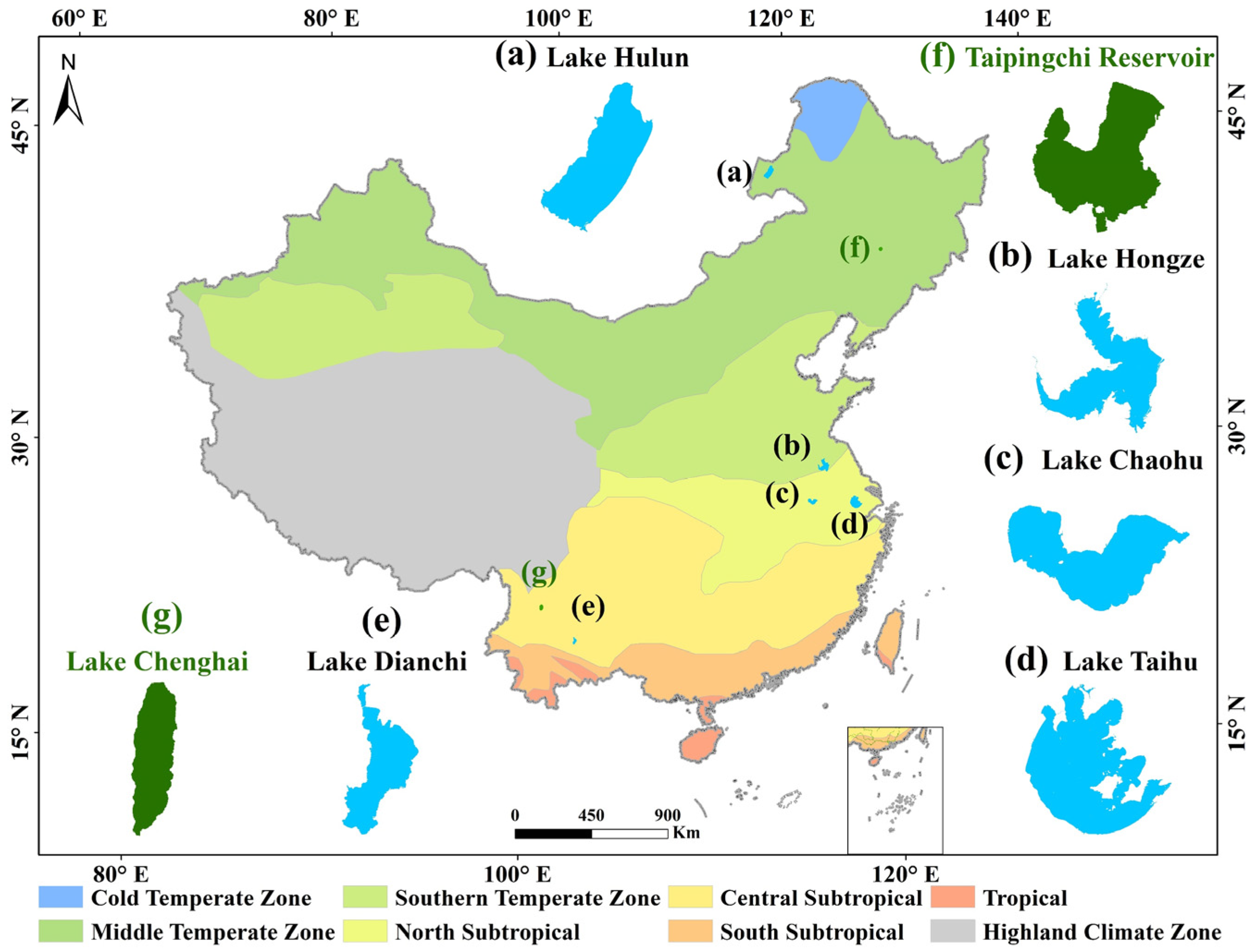

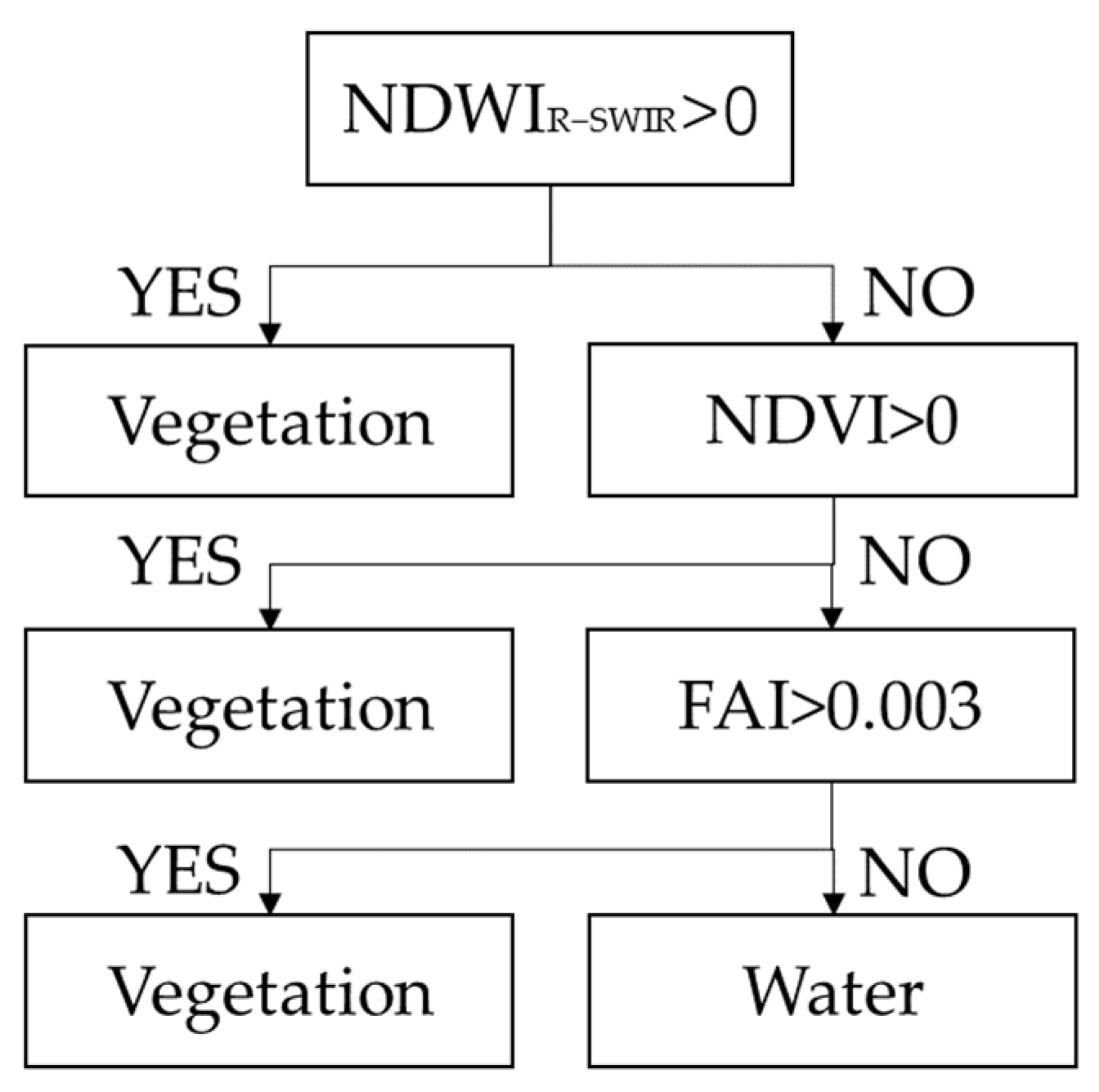
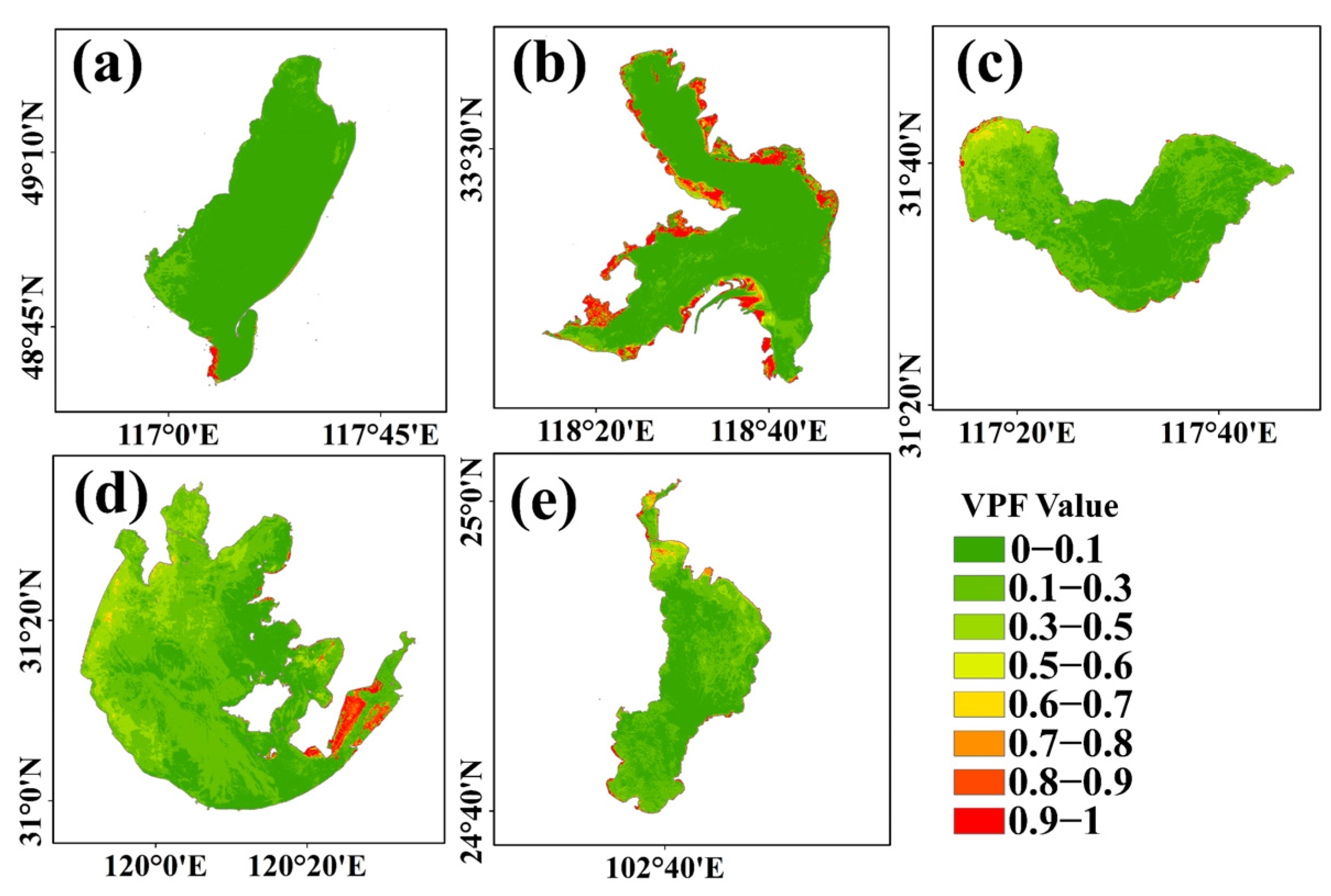
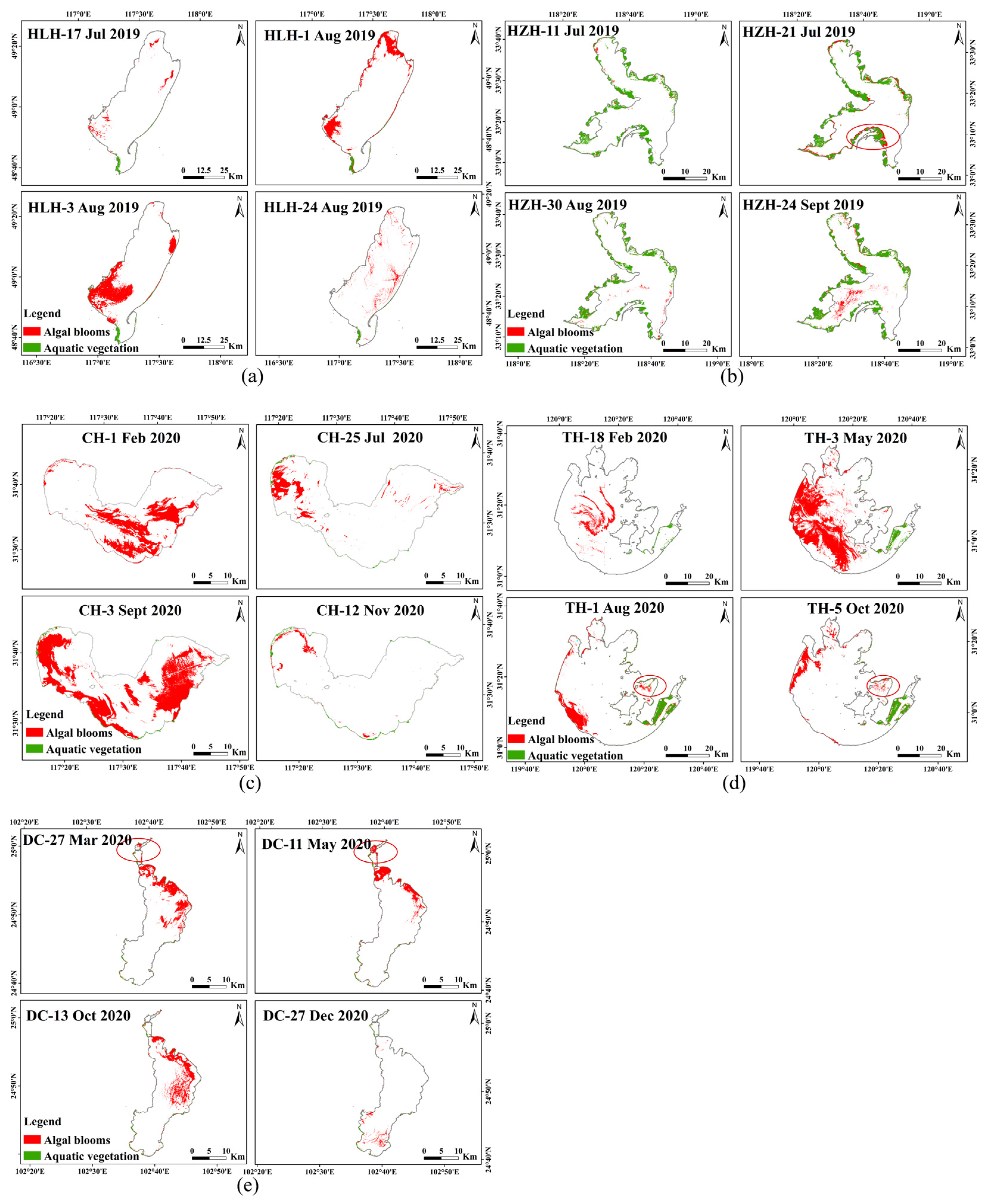
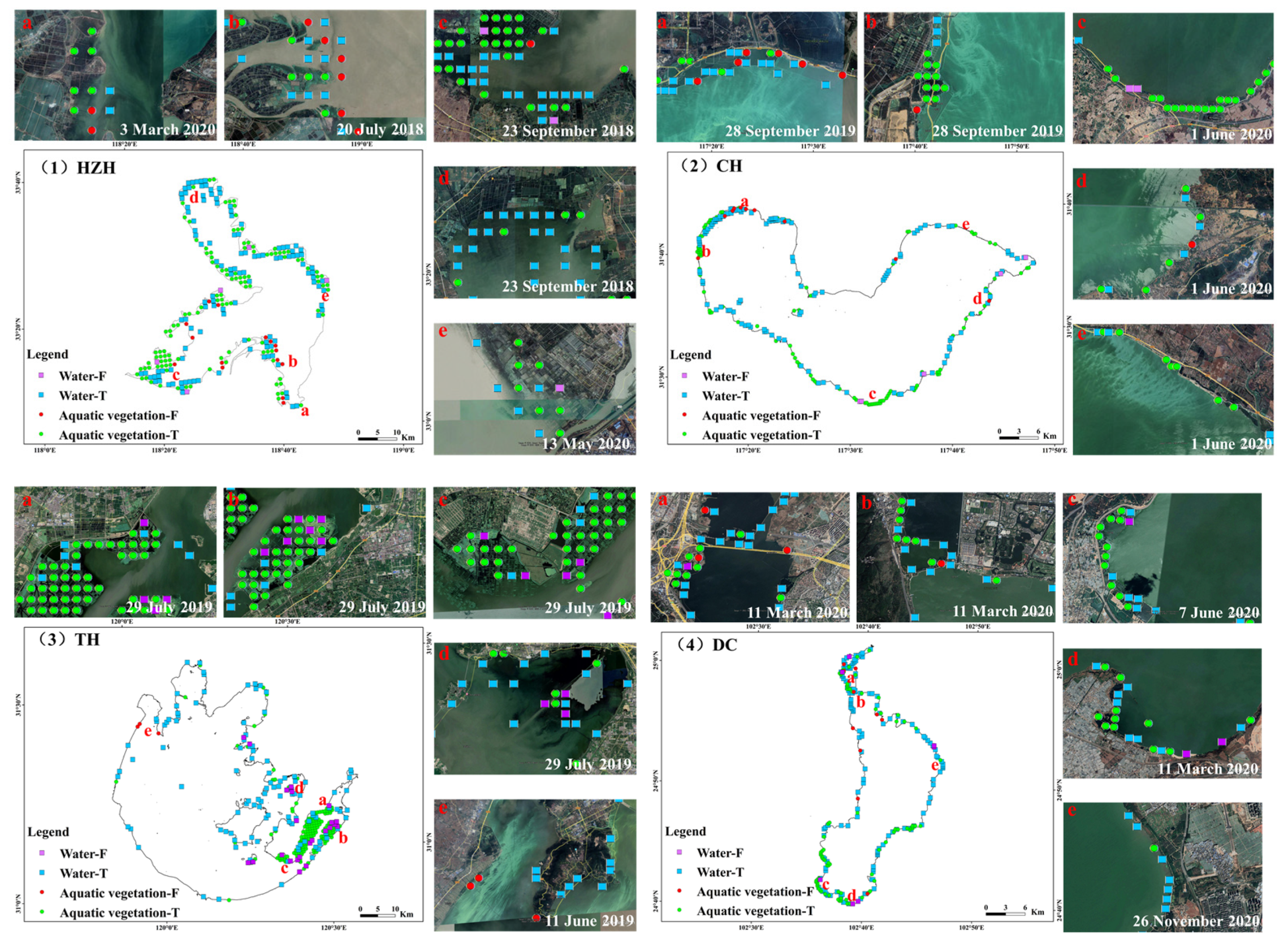
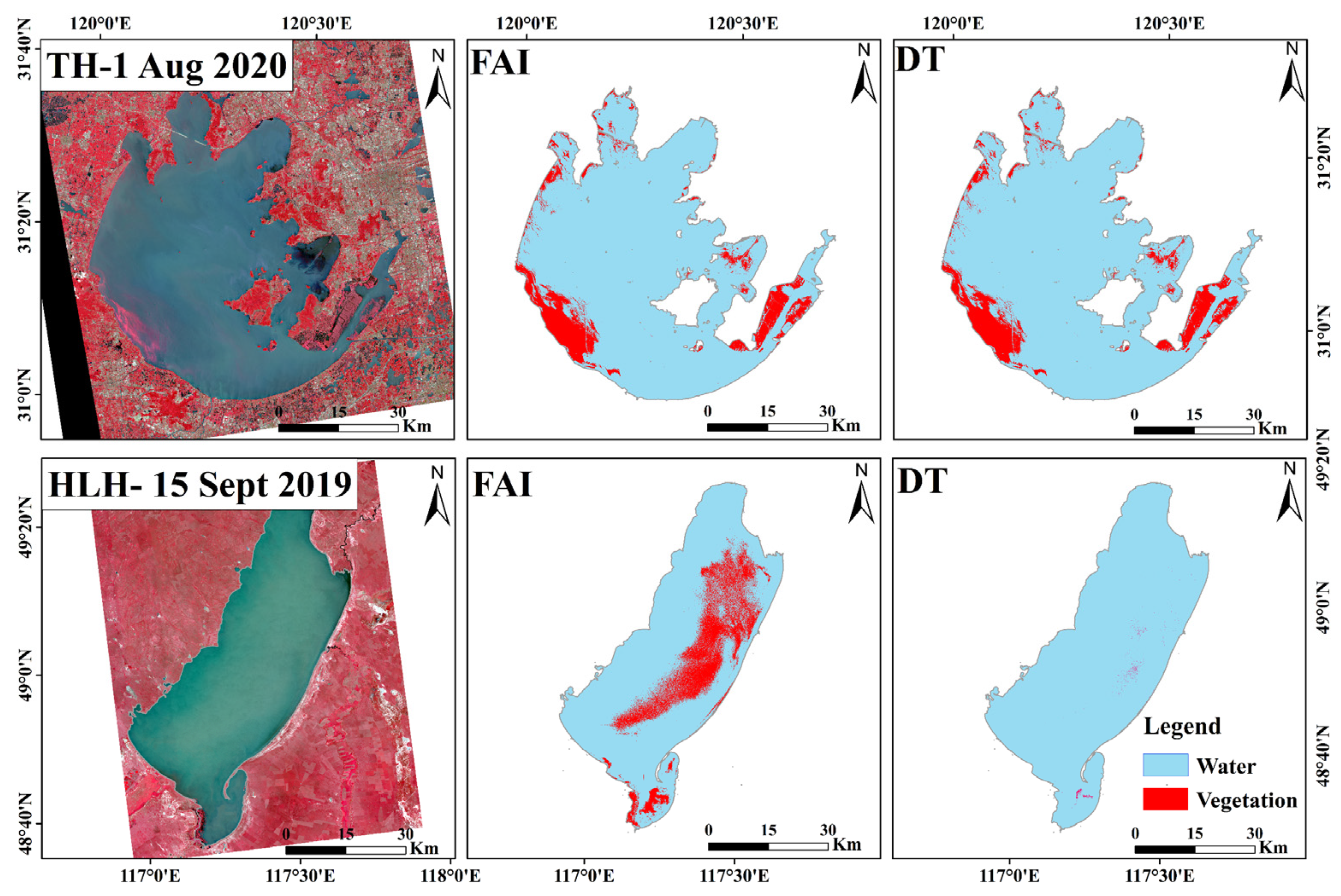
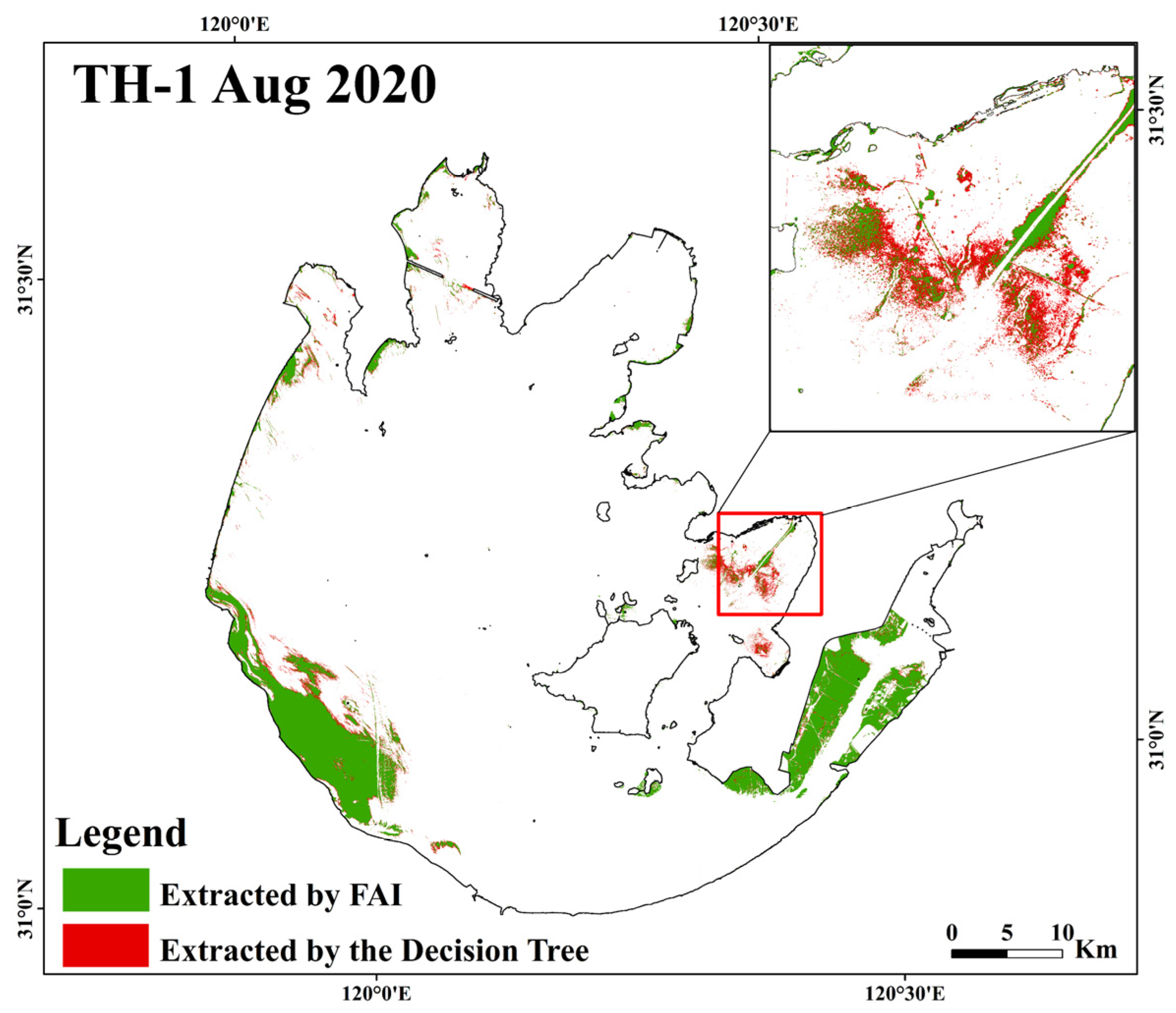
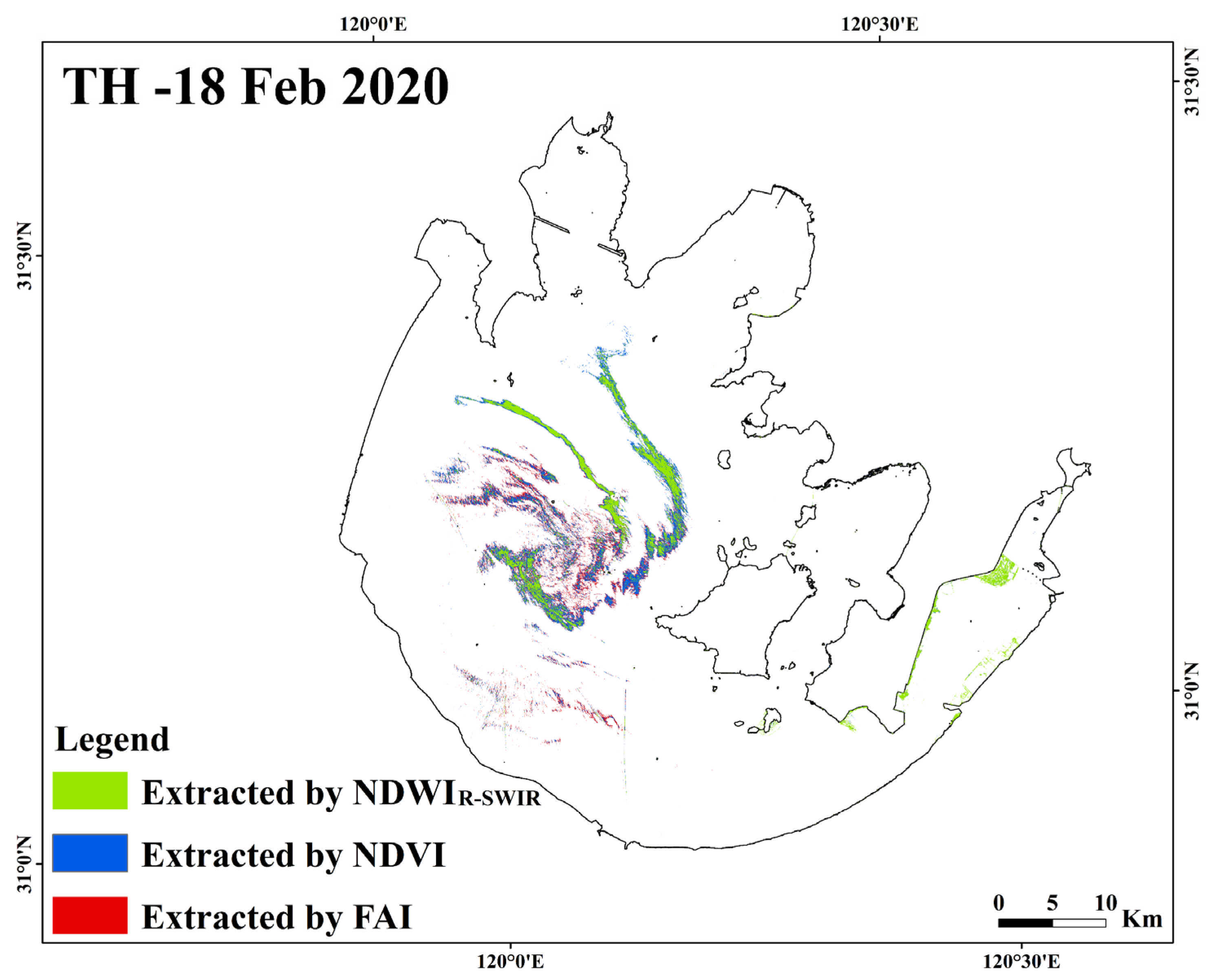
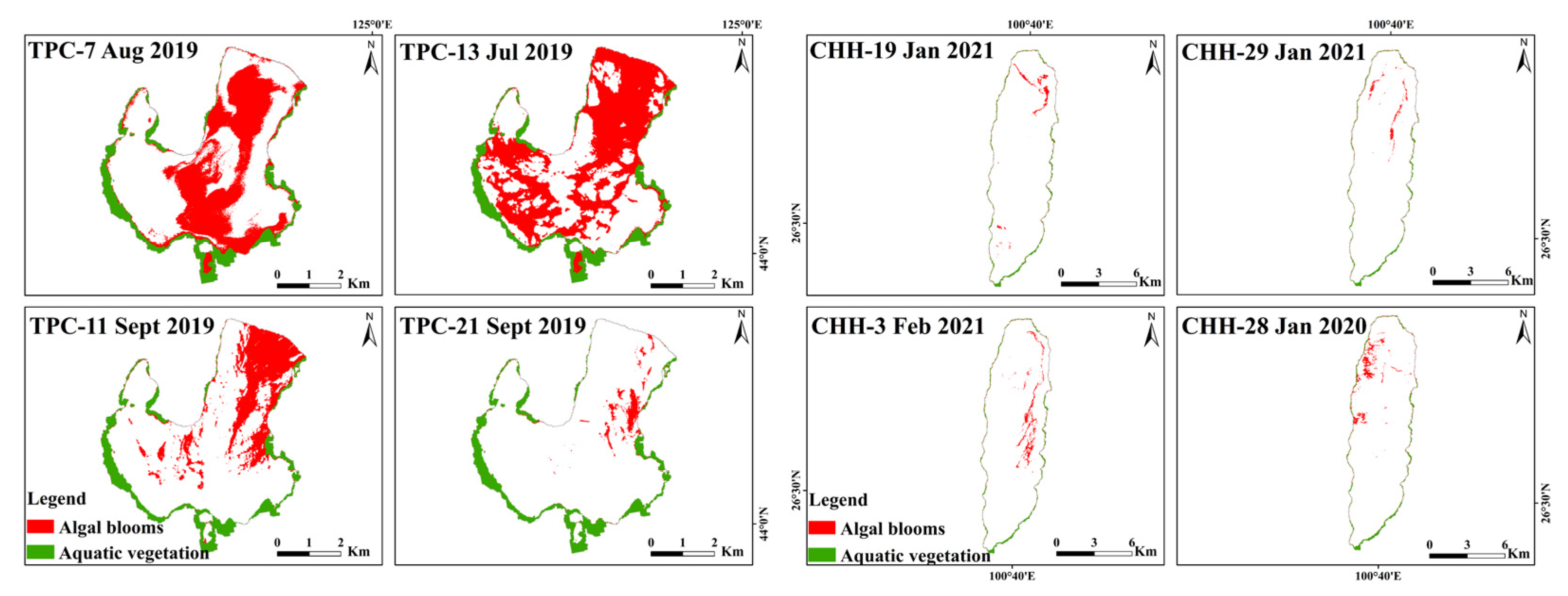
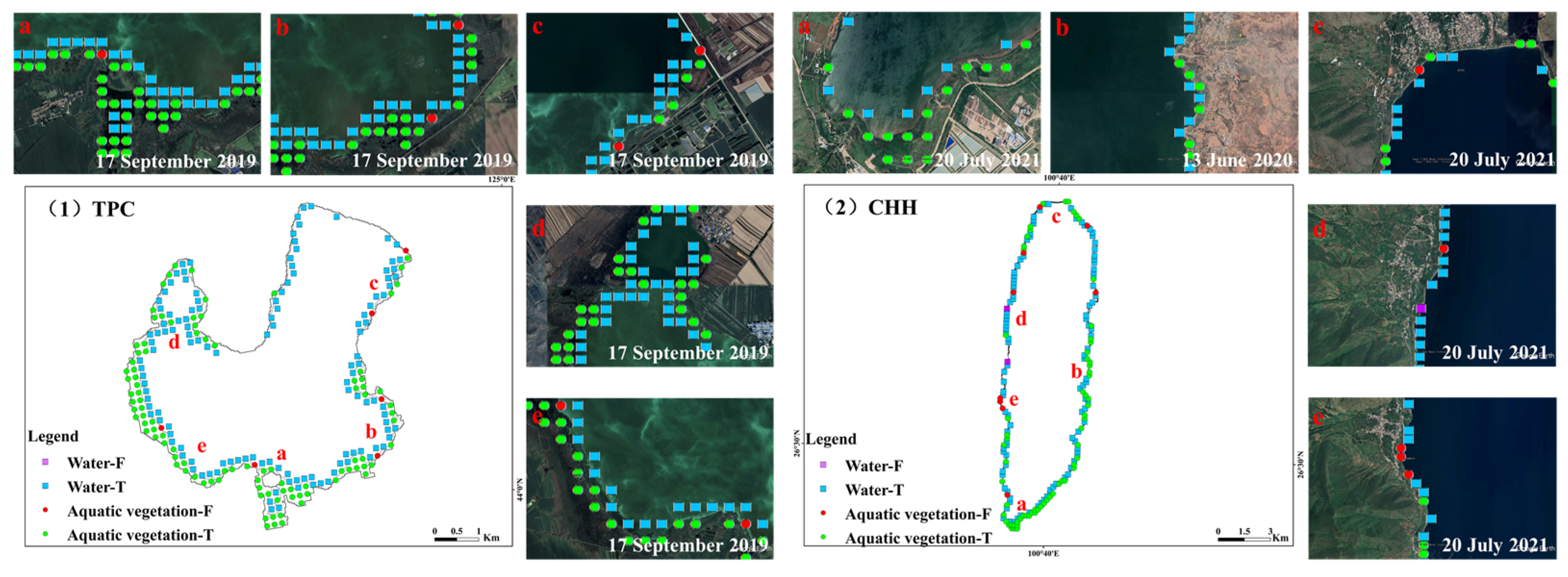
| Vegetation | Water | User Precision | Overall Precision (P) | Kappa | |
|---|---|---|---|---|---|
| Vegetation | 369 | 30 | 92.5% | 96.1% | 92.3% |
| Water | 0 | 375 | 100% |
| Lakes | Lake Chaohu | Lake Dianchi | Lake Hongze | Lake Taihu | ||||
|---|---|---|---|---|---|---|---|---|
| Results | T | F | T | F | T | F | T | F |
| Aquatic vegetation | 106 | 10 | 85 | 10 | 120 | 15 | 156 | 3 |
| Pv | 91.4% | 89.5% | 88. 9% | 98.1% | ||||
| Nonaquatic vegetation | 120 | 5 | 139 | 7 | 109 | 5 | 111 | 23 |
| Pw | 96% | 95.2% | 95.6% | 82.8% | ||||
| Pn | 87.7% | 85.2% | 85.0% | 81.3% | ||||
| Lakes | Taipingchi | Chenghai | ||
|---|---|---|---|---|
| Results | T | F | T | F |
| Aquatic vegetation | 98 | 6 | 66 | 9 |
| Pv | 94.23% | 88% | ||
| Nonaquatic vegetation | 128 | 0 | 112 | 2 |
| Pw | 100% | 98.25% | ||
| Pn | 94.23% | 86.65% | ||
Publisher’s Note: MDPI stays neutral with regard to jurisdictional claims in published maps and institutional affiliations. |
© 2022 by the authors. Licensee MDPI, Basel, Switzerland. This article is an open access article distributed under the terms and conditions of the Creative Commons Attribution (CC BY) license (https://creativecommons.org/licenses/by/4.0/).
Share and Cite
Pu, J.; Song, K.; Lv, Y.; Liu, G.; Fang, C.; Hou, J.; Wen, Z. Distinguishing Algal Blooms from Aquatic Vegetation in Chinese Lakes Using Sentinel 2 Image. Remote Sens. 2022, 14, 1988. https://doi.org/10.3390/rs14091988
Pu J, Song K, Lv Y, Liu G, Fang C, Hou J, Wen Z. Distinguishing Algal Blooms from Aquatic Vegetation in Chinese Lakes Using Sentinel 2 Image. Remote Sensing. 2022; 14(9):1988. https://doi.org/10.3390/rs14091988
Chicago/Turabian StylePu, Jing, Kaishan Song, Yunfeng Lv, Ge Liu, Chong Fang, Junbin Hou, and Zhidan Wen. 2022. "Distinguishing Algal Blooms from Aquatic Vegetation in Chinese Lakes Using Sentinel 2 Image" Remote Sensing 14, no. 9: 1988. https://doi.org/10.3390/rs14091988
APA StylePu, J., Song, K., Lv, Y., Liu, G., Fang, C., Hou, J., & Wen, Z. (2022). Distinguishing Algal Blooms from Aquatic Vegetation in Chinese Lakes Using Sentinel 2 Image. Remote Sensing, 14(9), 1988. https://doi.org/10.3390/rs14091988









